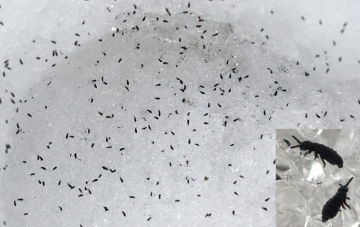

PHOTO COURTESY OF GARRY KESSLER
Snow fleas (springtails) in the snow, and (in the inset) as photographed with a macro lens.
April 7, 2017, Page A8
NATURE NOTES
By Annie Reid
Westborough Community Land Trust
Snow Fleas
Have you ever seen or even heard of snow fleas – a sign of spring in the snow?
In the late-winter or early-spring woods, have you noticed snow that looked almost sooty with black specs, especially at the base of a tree or in the melting hollows of old footprints? If you took a closer look, did you see some of those specs jumping around like fleas?
These tiny specs – only 1/16 - 1/8 inch long – are known as snow fleas, but in spite of their jumping, they’re not really fleas, or even insects. (Don’t worry, they won’t bite you or your pets.) Instead, they’re springtails (order Collembola), tiny creatures named for the tail-like body part that enables them to spring through the air. They can travel up to 100 times their body length, or up to a foot, in a single leap.
Springtails are arthropods, like insects, spiders, lobsters, crabs, and shrimp.
What are they doing in the snow? Throughout the year, springtails normally live by the thousands in damp soil and leaf litter, where they eat dead plant matter and help to recycle it. In winter, they take shelter under the snow, but in warm spells, they come to the surface of the snow and jump around. Why? Perhaps it’s no coincidence that spring is their mating season.
How do they jump? Their springing mechanism is a forked “tail” (unlike real fleas, which jump with their back legs).The “tail” stays folded under their body where it’s held tightly until it’s released, and then it snaps into a straight position, flinging its owner through the air. Springtails don’t control the direction or distance of their jumps, but they sure do take off from one place and land in another.
Why don’t springtails freeze and die in the snow? Their secret is an anti-freeze protein (AFP for short). It binds to ice crystals just as the crystals begin to form in the body. This binding blocks further growth of the crystals, preventing them from getting larger and damaging body cells. Certain frogs, cold-water fish, and evergreen plants also have similar anti-freeze proteins that allow them to survive freezing temperatures. Researchers are studying the anti-freeze protein in springtails in hopes of figuring out how to make substances that will be useful in storing and preserving all sorts of things, from ice cream to organs awaiting transplant.
Springtails do us good in their role of recyclers in the forest. They munch and break down dead plant matter, microorganisms, and fungi. Among the predators that eat springtails are beetles, ants, and mites.
Springtails have an external skeleton (like lobsters). And as you can see in the photo, they have six legs, a segmented body, and antennae. The tips of their antennae contain chemical sensors that “taste” the environment.
If you missed out on seeing springtails this year, remember to look for them in the snow on warm days next winter.